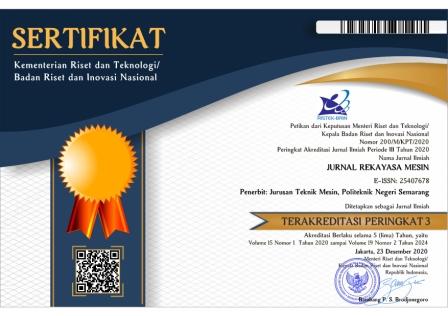Mechanical Properties and Homogenous Analysis of Semirigid Polyurethane Foam used in Headliner Roof Top Manufacturing Process
DOI:
https://doi.org/10.32497/jrm.v20i2.6575Keywords:
formability, simulation, semirigid polyurethane foam, true experimentAbstract
In the automotive industry with four wheels or more, polyurethane is used as the main material in making roof top headliners. The process of making roof top headliners often experiences product defects, namely breaks (cracks or fractures). The study was conducted to analyze the homogeneity of mechanical characteristics at various positions in one block of polyurethane foam that had been cut into sheets with a thickness of 8 mm. Samples were taken representing vertical and horizontal positions and tested using the true experiment spatial sampling method. From this study, it was found that the density in one block of semi-rigid polyurethane foam was not homogeneous. There were differences in density in the upper, middle and lower materials in zones 1 to 9. The density value is directly proportional to the bending strength value and inversely proportional to the elongation value. In the zone where the elongation value is low, there is a risk of product defects in the form of fractures if the product's formability strength simulated using NX software is higher than 18%.
References
[1] S. Ju et al., “Preventing the Collapse Behavior of Polyurethane Foams with the Addition of Cellulose Nanofiber,” Polymers (Basel), vol. 15, no. 6, Mar. 2023, doi: 10.3390/polym15061499.
[2] I. Dolgopolskp and J. A. Duley, “Polyurethane Foam as an Integral ‘Core’ Component of Automotive Headliner,” Journal of Industrial Textiles, vol. 30, no. 1, 2000, doi: 10.00/0.
[3] F. M. De Souza, P. K. Kahol, and R. K. Gupta, “Introduction to Polyurethane Chemistry,” 2021, American Chemical Society. doi: 10.1021/bk-2021-1380.ch001.
[4] K. B. Park, H. T. Kim, N. Y. Her, and J. M. Lee, “Variation of mechanical characteristics of polyurethane foam: Effect of test method,” Materials, vol. 12, no. 7, 2019, doi: 10.3390/ma12172672.
[5] G. Węgrzyk, D. Grzęda, and J. Ryszkowska, “The Effect of Mixing Pressure in a High-Pressure Machine on Morphological and Physical Properties of Free-Rising Rigid Polyurethane Foams—A Case Study,” Materials, vol. 16, no. 2, Jan. 2023, doi: 10.3390/ma16020857.
[6] K. Choupani, A. Shalbafan, and J. Welling, “Effect of ingredient ratios of rigid polyurethane foam on foam core panels properties,” J Appl Polym Sci, vol. 134, pp. 44722–44729, May 2017, doi: 10.1002/app.44722.
[7] M. Sonnenschein, Polyurethanes: Science, Technology, Markets, and Trends. 2014. doi: 10.1002/9781118901274.
[8] C. Oppon, P. M. Hackney, I. Shyha, and M. Birkett, “Effect of Varying Mixing Ratios and Pre-Heat Temperature on the Mechanical Properties of Polyurethane (PU) Foam,” in Procedia Engineering, Elsevier Ltd, 2015, pp. 701–708. doi: 10.1016/j.proeng.2015.12.550.
[9] M. Rampf, O. Speck, T. Speck, and R. H. Luchsinger, “Structural and mechanical properties of flexible polyurethane foams cured under pressure,” Journal of Cellular Plastics, vol. 48, no. 1, pp. 53–69, Jan. 2012, doi: 10.1177/0021955X11429171.
[10] S. H. Kim, B. K. Kim, and H. Lim, “Effect of isocyanate index on the properties of rigid polyurethane foams blown by HFC 365mfc,” Macromol Res, vol. 16, no. 5, pp. 467–472, 2008, doi: 10.1007/BF03218546.
[11] D. W. Karmiadji and Alimudin, “Analisis Material Berbasis Polyurethane Foam Infill (PUF) Untuk Head Lining Atap Kendaraan.,” Teknobiz : Jurnal Ilmiah Program Studi Magister Teknik Mesin, vol. 10, no. 1, pp. 1–6, 2020, doi: 10.35814/teknobiz.v10i1.1354.
[12] D.-A. Șerban and E. Linul, “Fatigue behaviour of closed-cell polyurethane rigid foams,” Eng Fail Anal, vol. 154, p. 107728, 2023, doi: https://doi.org/10.1016/j.engfailanal.2023.107728.
[13] D. Niyogi, R. Kumar, and K. Gandhi, “Water blown free rise polyurethane foams,” Polym Eng Sci, vol. 39, pp. 199–209, Jan. 1999, doi: 10.1002/pen.11408.
[14] S. Sivakumar and B. Navin Kumar, “Enhancement of bending strength of polyurethane foam reinforced with basalt fiber with silica nanoparticles in comparison with plain polyurethane foam,” Mater Today Proc, vol. 79, pp. 69–74, 2023, doi: https://doi.org/10.1016/j.matpr.2022.08.343.
[15] Mihail Ionescu, Chemistry and Technology of Polyols for Polyurethanes, vol. 26. Shawbury: Rapra Technology, 2006.
[16] A. Nandanwar, K. Chandroji Rao, and K. Varadarajulu, “Influence of Density on Sound Absorption Coefficient of Fibre Board,” Open Journal of Acoustics, vol. 07, pp. 1–9, Jan. 2017, doi: 10.4236/oja.2017.71001.
Downloads
Published
How to Cite
Issue
Section
License
Copyright (c) 2025 Adi Nugroho, Antonius Fajar Bisma, Perwita Kurniawan

This work is licensed under a Creative Commons Attribution-NonCommercial-ShareAlike 4.0 International License.
Copyright of articles that appear in Jurnal Rekayasa Mesin belongs exclusively to Penerbit Jurusan Teknik Mesin Politeknik Negeri Semarang. This copyright covers the rights to reproduce the article, including reprints, electronic reproductions, or any other reproductions of similar nature.







